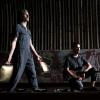
What’s the difference between Hawaii’s Kilauea volcano and Magma, Post:ballet’s upcoming production, Jan. 23–26 at The Midway in San Francisco? Actually, not much: They’re both hot and dangerous. But while park rangers on the Big Island make sure thrill-seeking tourists stay at a safe distance, the Bay Area dance troupe wants you to immerse yourself in this multifaceted production, which is slated to be the company’s final offering before closing down this month.
Magma has been two years in the making, and in a recent interview with SF Classical Voice, Associate Artistic Director Moscelyne ParkeHarrison delved into its creation. She said that Artistic Director Robin Dekkers “asked me to make a full-length piece after I had gotten involved with the company.” Post:ballet’s previous big piece, Lyra, had been “a huge work that defined the company for a few years,” noted ParkeHarrison. “It was a lot of pressure and also a huge invitation to dream.”

She explained how Dekkers encouraged her to stick to her style. “Robin had gotten to know my work through my company BODYSONNET, which does site-responsive and site-specific work, so Robin’s impression of my choreography was mainly things that take place in really nontraditional environments. When I first imagined making a piece for Post:ballet, I was actually excited to maybe do something for a stage [production]. Then Robin came to me and said, ‘Why don’t we do something completely immersive? It would also be a new adventure for Post:ballet.’”
The venue for Magma, the nightclub The Midway, abuts one of San Francisco’s industrial neighborhoods and has six separate event spaces that have afforded tremendous flexibility in staging this complex, multilayered production.

ParkeHarrison described the various threads of thought behind the piece:
“I was interested in creating something a bit more allegorical, using [myth] to understand how we in society perceive morality now. I was fascinated by so much extremist thought, both liberal and the opposite — and the fine line where both those things meet. I wanted to use the archetype of the Cassandra narrative. You will always have someone on the other end saying something’s not true, and they will have a great reason why they believe it. The belief is actually the interesting thing, not the truth.
“Climate change is also a huge discussion that’s getting more and more heated, no pun intended. But I think that the irony of trying to understand and control the Earth is a very new thing, as far as the longevity of the Earth goes. [I’m] trying to create a really layered narrative that in fact isn’t a narrative at all. It’s more an encapsulation of a state. The metaphor of a volcano feels akin to a myth; it’s one of the natural disasters that we still really can’t predict or control or even attempt to understand.

“Magma is impending, always beneath the surface, something we’re both afraid of and also fascinated by. I didn’t want to make something that felt inherently evil or good, so I tried to focus on the sublime — something that’s so big and beyond yourself and can be as terrible as an explosion or as beautiful as a sunrise.”
The production is in three parts and features nine performers. Every audience member will experience a different show, moving independently through the venue’s rooms and spaces — though there will be times when everyone is together.
Which is a fitting way to say farewell. Ahead of this weekend’s performances, Dekkers, who uses they/them pronouns, shared their thoughts and feelings on the decision to disband the company:
“The journey that brought me to make Post:ballet allowed it to evolve and shape-shift, and we let each project be its own thing and go its own way. Post:ballet requires a lot of effort, and I had hopes of seeing the company grow to a place where it could be passed on to someone else. But the reality is funding is everything, and Post:ballet reached a point where it wasn’t sustainable for me or the organization to continue. It really does take a village to keep arts organizations and nonprofits going, and despite the contributions of so many patrons, foundations, staff members, and volunteers, the cost of presenting work at the level we’ve been creating at — high production values and competitive wages for artists — ultimately exceeded our fundraising capacity.
“[Nonetheless] it’s been just wonderful to see what kind of ecosystem is emerging here and how I can nurture that. This city is just teaming with the next generation. They have such vision and yet work with such humanity. They’re already starting from such an evolved place. I can’t wait to see what their worlds become. Making Post:ballet and creating this community has been the greatest joy of my life.
“I want to encourage everyone to show up. Take a risk. Go to something that you like or don’t know what it is. Just go and support the things that you love because they’re not guaranteed.”




